Analysis of the KTH Report
A report has been produced by KTH, Energy technology, in the lab of Applied Thermodynamics and Refrigeration in 2008 and concerns the performances of the first Sanyo Eco Cute Heat Pump adapted for the Swedish market.
With many tests in laboratory, the difference aspects of the system have been studied: the performances of the heat pump in itself (outside unit) and the performances of the whole system in operation with different load. The defrost cycle and the temperature distribution in the tank have also been analysed.
The study of the heat pump in itself confirmed the COP given by the manufacturers in the corresponding conditions of operations. It also showed that the heat pump performance is largely dependent on the outside temperature and the return water temperature from the gas cooler (figure below).
The measurements below have been realized over a period of 30min while the system operation was quite stable. Many graphs show that that the system performances are fluctuating.
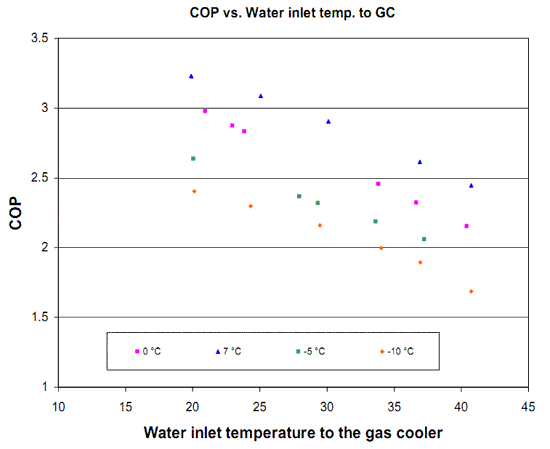
The report also state that the European heat pump testing standards are not really adapted for CO2 heat pump since they are realized at quite high return temperature to the Heat pump which is very unfavourable in the case of the CO2 cycle. They advise that CO2 heat pump should be used with low temperature heating system.
Performance of the whole system
The whole Sanyo system (tank + heat pump) has also been studied with certain heating loads (but no domestic hot water demand). The graphs below show the results of the tests.
The COP seemed to be a bit lower than conventional heat pump. This is mainly due to the fact that the tank delivers a quite high return temperature to the heat pump. The design of the tank doesn’t seem to have been optimized to minimize the temperature at the bottom. In particular the stratification is often destroyed when the heat pump starts running.
The analysis of the results indicates that the return water temperature to the heat pump at fixed outside temperature seemed to be the main one determining the performance of the heat pump.
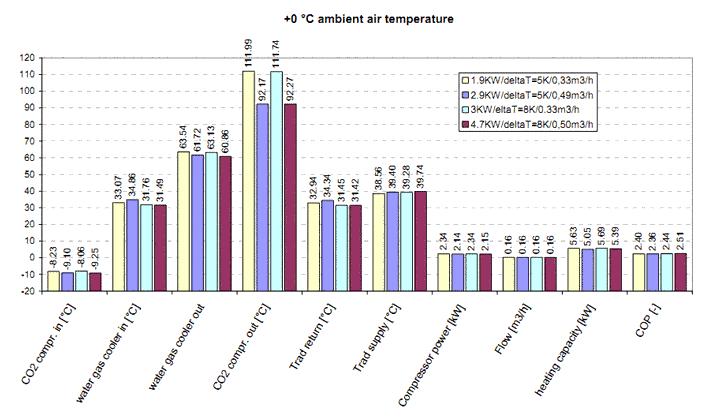
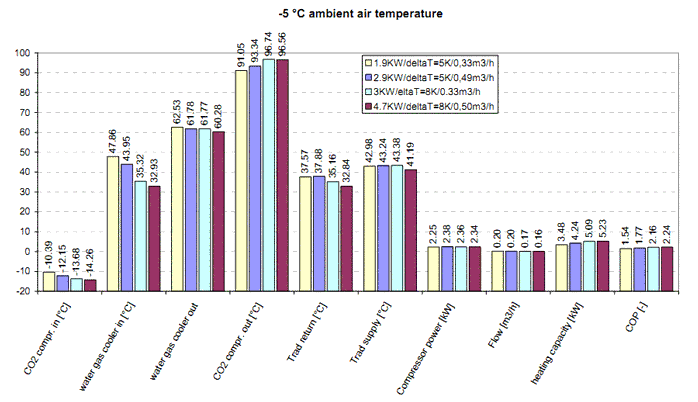
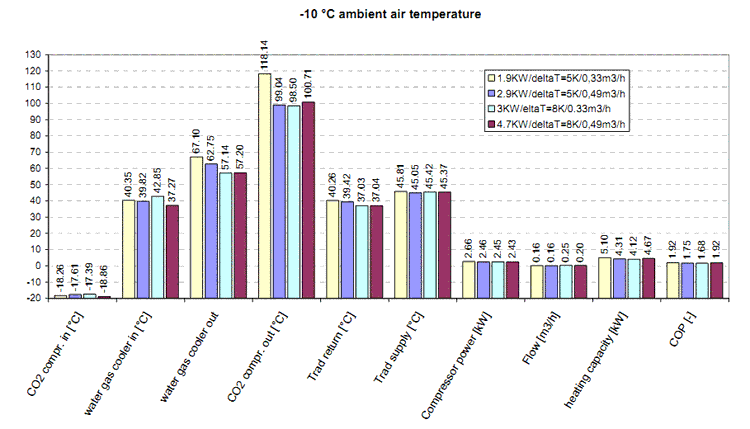
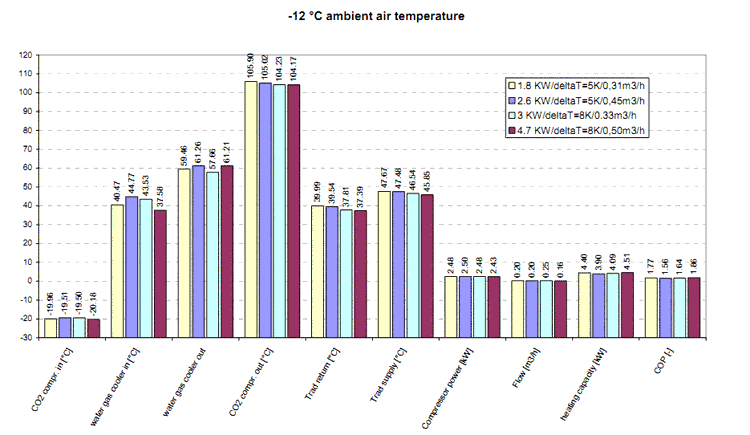
The report states that the ratio between the space heating demand and the hot water demand is a key parameter for the system operation. A ratio with an important part of domestic hot water would tend to provide a lower return temperature to the heat pump. However no test was made to validate this hypothesis and assess the real improvement.
The operation of the defrost cycle has finally been studied. The graph below show the evolutions of many parameters during a defrost cycle.
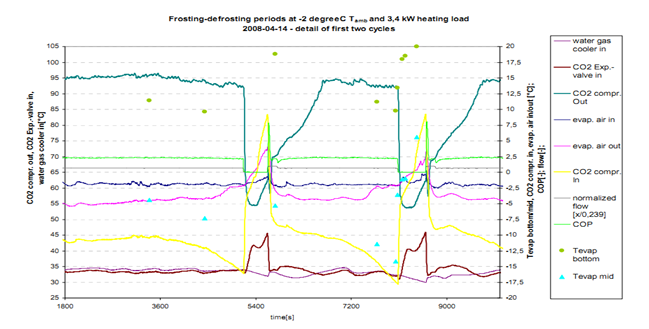
Suggested improvement
Several improvements in the design of the tank have been suggested in order to minimize the temperature at the bottom of the tank:
- improving the connection of the different parts of the tank to assure that the hot water in the middle of the tank go up and the cold water at the top go down. The connecting pipes were not really well positioned.
- adding one extra partition plate at the bottom of the tank to try to minimize the water temperature at the bottom.
- positioning the return loop from the Heat pump at the top of the tank (above the partition plate), in order to maintain the stratification in the tank when the heat pump is operating.
- positioning the coil of the cold water from the city at the bottom of the tank in order to use its cooling capacity to decrease the temperature of the return water flow to the heat pump.
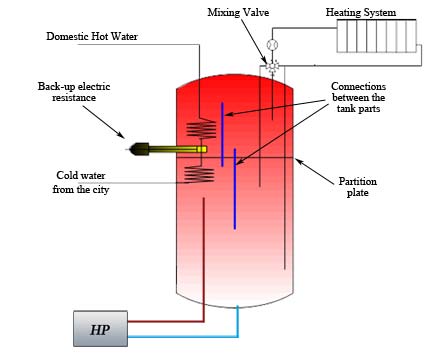
First version of the Sanyo Eco cute
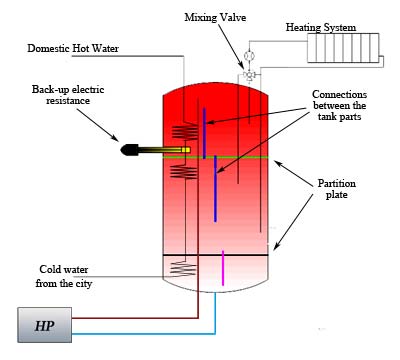
Modification suggested in the report
Analysis of the report
The tests carried out on the heat pump are quite useful and will be used in our modelling part in order to realize the multiple regression of the COP.
The tests realized on the whole system are more difficult to analyze. The modification made on the pipes connections (to have a better control over the return temperature to the gas cooler) changed significantly the configuration for the system operation. In addition, the system has been only tested for space heating without any domestic hot water demand which limit the scope of the results given.
It is suggested in the report that an important ratio of the domestic hot water demand would enable to decrease the return temperature to the Heat Pump. In the actual design of the system, the real improvement is nevertheless not so evident.
This report is about the old version of the Sanyo Eco cute system. For the new version, Sanyo would have followed some of the recommendations made in this report concerning the design of the tank. One partition plate has been added at the bottom and the circulation between the sections of the tank would have been improved. The real changes in terms of performances are questionable.
Both other recommendations would have probably brought a better improvement to the performances of the system. These changes in the design have however not been done: it would have indeed required a significant modification of the existing system and its control.
Bibliography
1. Yank Chen et Al., CO2 Heat Pump for the Swedish market – Test and analysis of the Sanyo Eco-Cute heat Pump modified for Swedish conditions. 2008, KTH University , Energy technology, lab of Division of Applied Thermodynamics and Refrigeration. Available online at http://effsysplus.se/wp-content/filesystem/tidigare_program/effsys2/Publicerade%20dokument/P03/P3%20slutrapport.pdf















